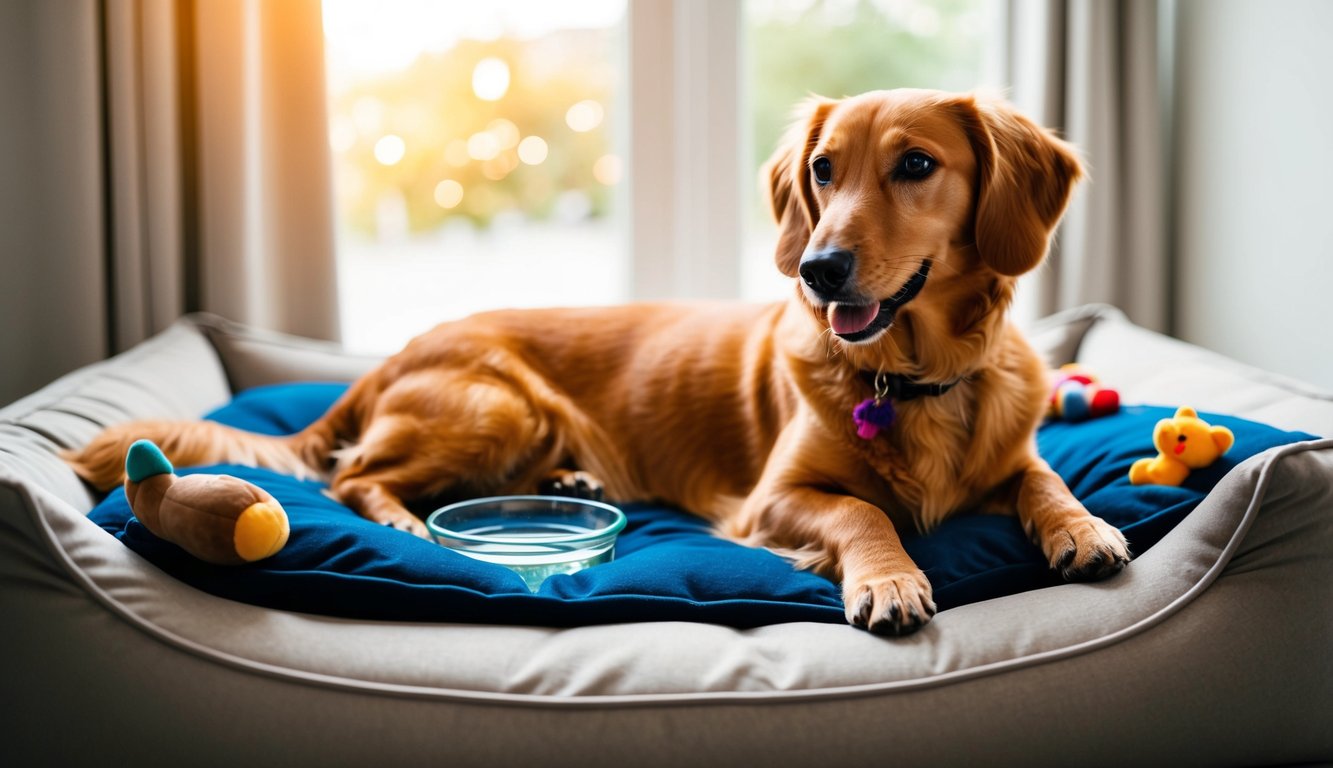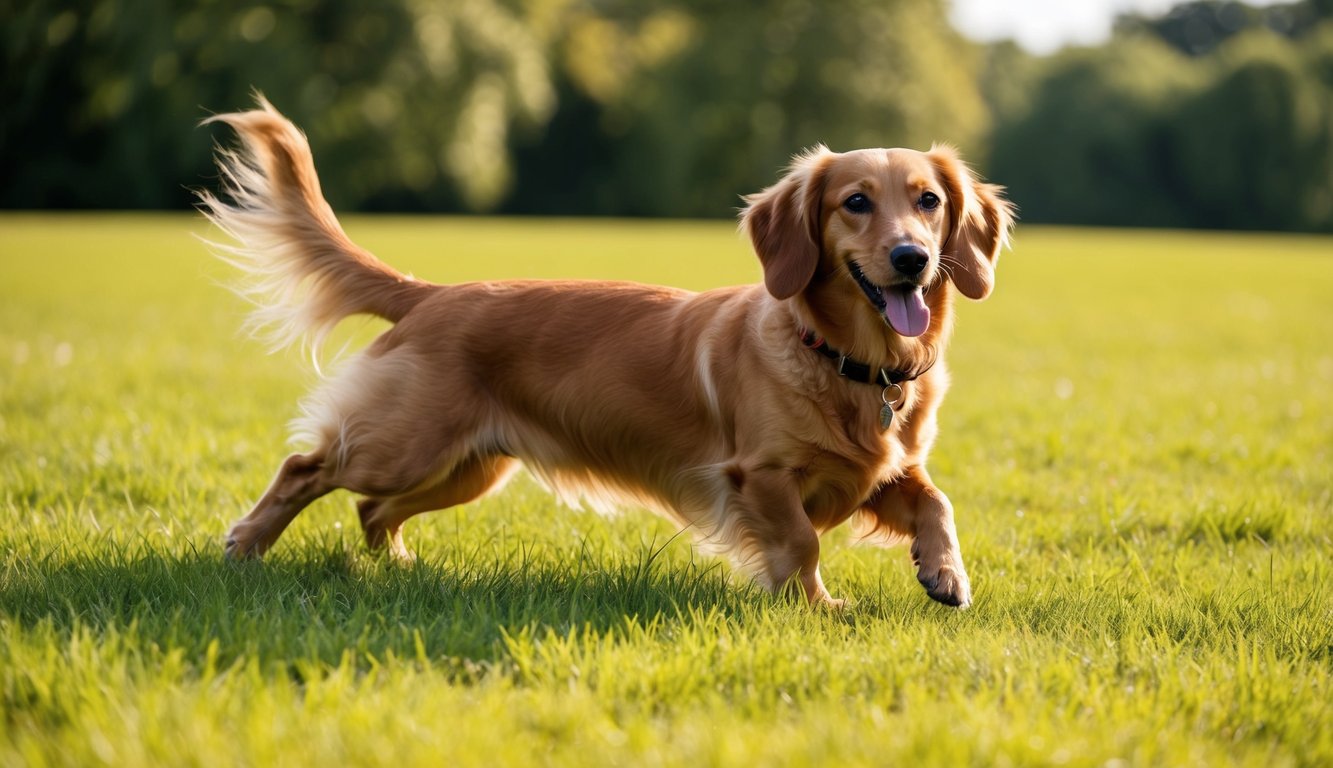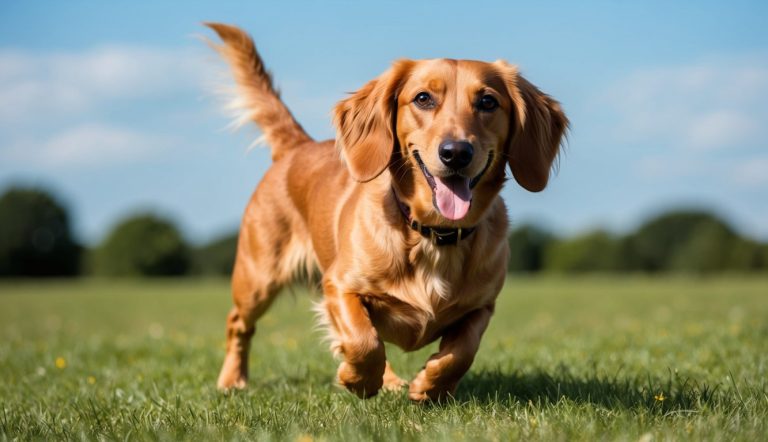The Golden Dox combines the friendly nature of a Golden Retriever with the distinctive body shape of a Dachshund. This unique mixed breed brings together two beloved dog breeds to create a pet with distinct physical features and an engaging personality. Let’s explore this cute breed!
If you’re still on the market to buy a Goldendox, PuppySpot currently offers a $300 discount using the code PUPPY300, just click the banner below!
Physical Characteristics
- The Golden Dox typically measures 10 to 23 inches in height and weighs between 30 to 60 pounds. Their size can vary significantly depending on which parent breed’s genes are more dominant.
- These dogs usually have a long body and shorter legs, inherited from their Dachshund parent. Their ears tend to be high-set and folded over.
- Their coat is dense and shiny, requiring regular grooming to maintain its condition. Colors can range from golden to brown or black.
- Most Golden Dox dogs have a muscular build with a long snout and brown eyes.
Personality Traits
- These dogs show strong loyalty to their families and often form deep bonds with their owners. They inherit the Golden Retriever‘s friendly nature and the Dachshund’s brave spirit.
- Both parent breeds love being with their people, making the Golden Dox an affectionate and social companion.
- They display intelligence and eagerness to please, though they might show some stubbornness from their Dachshund heritage.
- These dogs typically get along well with children and other pets when properly socialized.
- Energy levels tend to be moderate, requiring daily exercise but not as intense as a purebred Golden Retriever.

Health and Care
The Golden Dox needs specific care to maintain good health, from managing their unique body structure to providing proper nutrition and exercise. Regular vet checkups and a consistent care routine help prevent potential health problems.
Common Health Issues
- The Golden Dox can live 10 to 14 years with proper care. Their mixed heritage brings health concerns from both parent breeds.
- Back problems are a major concern due to their long spine. Intervertebral Disc Disease (IVDD) requires special attention to prevent injury.
- Hip dysplasia can affect these dogs, especially in larger Golden Dox specimens. Regular vet checks help catch joint issues early.
- Eye problems like Progressive Retinal Atrophy may develop. Early detection through routine screenings is essential.
Diet and Nutrition
A balanced diet helps maintain healthy skin and coat. Feed high-quality dog food appropriate for their size and activity level. Adult Golden Dox needs 2-3 meals daily. Portion size depends on weight, which can vary greatly between individuals.
Recommended Foods:
- High-quality protein sources
- Healthy fats for coat health
- Limited ingredient diets if allergies present
- Fresh water available at all times
Exercise Requirements
These dogs need moderate daily exercise to stay healthy and prevent weight gain. A mix of activities works best.
Daily Exercise Plan:
- 30-45 minutes of walking
- Short play sessions
- Mental stimulation games
- Supervised yard time
Avoid high-impact activities that could strain their back. Swimming provides excellent low-impact exercise.
Grooming Needs
The Golden Dox has a dense coat that needs regular maintenance. Brush 2-3 times weekly to prevent matting.
Basic Grooming Schedule:
- Brush teeth 2-3 times weekly
- Trim nails every 2-3 weeks
- Clean ears weekly
- Bathe every 6-8 weeks
Seasonal shedding requires more frequent brushing. Professional grooming every 8-12 weeks helps maintain coat health. Monitor skin for signs of irritation or allergies. Use gentle, dog-specific grooming products.
Training and Behavior
The Golden Dox shows strong intelligence from both parent breeds, making them responsive to training. These dogs need consistent guidance to manage their sometimes stubborn nature.
Training Techniques
Early training helps establish good behavior habits in Golden Dox puppies. Positive reinforcement with treats and praise works best. Short, frequent training sessions keep their attention focused. These dogs can become bored with repetitive exercises.
Basic commands to teach:
- Sit and stay
- Come when called
- Leash walking
- Drop it/leave it
- House training
Behavioral Traits
The Golden Dox inherits a muscular build and energetic nature that requires proper outlets. Without enough activity, they may develop unwanted behaviors like digging or chewing. These dogs display loyalty and affection toward their families. They often show protective instincts while remaining friendly.
Common traits include:
- Playfulness: High energy levels
- Intelligence: Quick learners
- Stubbornness: May resist commands
- Alertness: Good watchdogs
Socialization Tips
Expose Golden Dox puppies to various people, pets, and situations early. This builds confidence and reduces fear-based reactions.
Take them to different places:
- Parks and neighborhoods
- Pet stores
- Friend’s homes
- Outdoor cafes
Regular playdates with other dogs help develop social skills. Supervise interactions to ensure positive experiences. Introduce them to children carefully and teach proper handling. The Golden Dox usually shows patience with kids but needs monitoring during play.

Living with a Golden Retriever Dachshund Mix
The Golden Dox adapts well to different living spaces and brings warmth and companionship to their families. These dogs have flexible housing needs and get along with most family members.
Suitable Living Environments
- The Golden Retriever Dachshund mix fits well in both houses and apartments. Their size can vary significantly, ranging from 10 to 60 pounds, so living space requirements depend on the individual dog.
- These dogs need moderate daily exercise to stay healthy and happy. A fenced yard provides an ideal space for play and exploration.
- Indoor living works well for these dogs as long as they get regular walks and playtime. Their exercise needs are less demanding than a pure Golden Retriever.
- A secure living area is important since these dogs may inherit a Dachshund’s tendency to dig or chase small animals.
Compatibility with Children and Pets
- Golden Dox dogs typically inherit friendly traits from both parent breeds. They show patience and gentleness with children when properly trained and socialized.
- Early socialization helps them develop good manners around other pets. Their hunting background means they might chase smaller animals, so supervision is essential.
- These dogs form strong bonds with family members. They do well in homes with older children who understand how to interact safely with dogs.
- Proper introductions to new pets should happen gradually. Many Golden Dox dogs live happily with cats and other dogs when raised together.
Lifespan and Aging
The Golden Retriever Dachshund mix, also known as the Golden Dox, typically lives 10 to 14 years. This lifespan is similar to many other medium-sized dogs. Mixed breed dogs often have better health than purebreds due to their diverse genes. The Golden Dox benefits from this genetic diversity, which can help prevent common inherited health issues.
Regular vet check-ups, proper diet, and exercise play key roles in extending a Golden Dox’s life. These mixed breeds stay playful and energetic well into their senior years.




